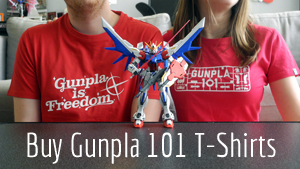
Pla plates, short for plastic plates, are what Gundam modelers call styrene sheets. Modelers use pla plates to add custom detail to existing kits. Let Dominic of Total Gunpla give you the rundown on this exciting customization accessory.
Pla plates, AKA styrene sheets, are a great way of adding detail to any kit. Styrene is a readily available thin plastic sheet you can find at any hobby shop, and in my opinion, is the best place to start learning how to scratch build and customize Gunpla.
Here’s an example of an MG Astray Red Frame with pla plates applied to its shoulders to look like wings and to its skirt to look like chainmail armor. This custom build by MatX shows just how big a difference pla plate can make!
In this tutorial, I’ll go over a step-by-step for elevating your Gunpla with pla plates.
1. Choose a large, plain area
Pla plates can add visual interest to areas of your model that are large and under-detailed. Some of the areas I look for include skirt armor, shoulders, and thighs.
2. Create your blueprint
Before you start slicing into the pla plate, you’ll want to test how it will look with a blueprint. The easiest way to do this is to attach a piece of modeling tape to the piece you want to detail and sketch your design onto the tape. When you’re satisfied, transfer the tape to your pla plate.
3. Cut the pla plate
There’s no single right way to cut pla plate, so I’m going to go over a few options.
- Scissors: If the plate isn’t too thick (2mm and under) you can use a pair of good scissors to cut the plate out. Make sure they’re sharp. If the plate does bend while you’re cutting it out, you can straighten it out afterward by placing it under a heavy book.
- Scriber: Use a scriber or knife to score lines around your custom part into the pla-plate. How deep you will have to score will be a matter of your preference (which you will find out with experience) and how thick the plate is. Once scored about halfway through, you can snap the pla plate out by bending it at the score. Or, you can cut all the way through; it takes longer but has a little less cleanup.
- Craft knife: The same technique as above, but with an X-Acto or similar knife.
4. Clean up the part
Unless you are using some fancy tools, the edge of the piece will be really rough. You’re going to trim it down and clean it up just as you would shave down a nub mark or scratch.

I recommend using a set of files to get it into shape and then sandpaper to finish. If there are areas the files don’t fit, you don’t have any, or it’s simply your preference, you can use your hobby knife to help with the shaping.
Pro tip: When cleaning up a sharp edge, avoid holding the sandpaper with your bare hands. Use a rigid sanding stick, sandpaper holder, or at the least wrap the sandpaper around a popsicle stick or file. If not, you risk a rounded edge.:
5. Bevel the part
If you examine some real machinery or your models, you’ll rarely find hard 90-degree edges. Instead, most of them will be beveled: cut to a sloping, slanting edge. We can recreate this by holding our hobby knife at the desired angle and gently scraping it along the part. Start in the center and move towards the edges one at a time.
6. Glue the part
Now it’s time to glue the pla plate to your original part. You can use either plastic cement or super glue for this. The former will give a stronger bond, but the latter will cure quicker.
It’s a good idea to first scratch the surfaces to be glued, giving you a better bond. I usually use a scriber for this, but a craft knife or chisel will also do.

You want to avoid any glue squeezing out onto the surrounding plastic as that would be messy, so keep the glue to the center of the piece and avoid using too much.
Once the glue is on both of the pieces, squeeze them together. If you have some clips you can use those for the squeezing and move onto something else; if not, just use your hands, it should only take 30 seconds for the adhesion to begin.

If you used plastic cement, I recommend giving the part 24 hours to properly cure. For super glue, an hour will be enough.
Simply by adding pla plate pieces to your base kit, you can add custom details that elevate the look and feel of the kit and make it all your own. I hope this tutorial has given you a taste of how pla plate can work as a customization technique.
Stay tuned for a followup on different types of pla plate shapes to try!
Dominic got his start in Gunpla with a 1/100 Destiny Gundam way back in 2006. At the moment he’s experimenting with new techniques to create models that make people put down their phones and say “That is awesome, I want to make one!” The journey is covered on his blog, TotalGunpla.com.













3 Comments.
Hi Lauren, it would be great if you guys can cover the more advance techniques (eg: Chamfer etc.. )
We’ve got a follow-up to this tutorial coming soon! But I’ll look into finding a contributor who can go into the more advanced pla-plate techniques, so thank you for your feedback!
Hi Kevz, what are the specific techniques you want to learn about? I’m happy to expand the tutorials.